Play review of the battle puzzle game 'Sagrada' that makes beautiful stained glass using 90 dice

As a stained glass craftsman of '
Sagrada Japanese version --Engames Shop
https://www.engames-s.com/product/831
The outer box of Sagrada looks like this. Beautiful stained glass is drawn.

The number of players is 1 to 4. The time required for one play is 30 to 45 minutes, and the target age is assumed to be 13 years or older.
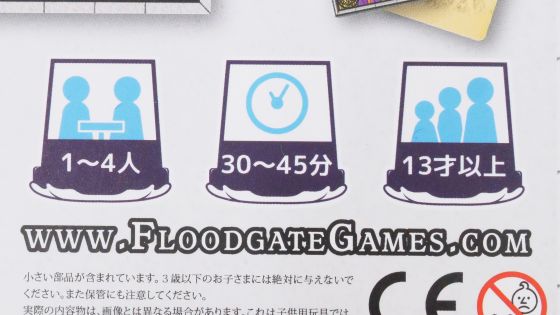
Inside the box are five colored dice: red, blue, green, yellow and purple. The number of dice is 18 for each color, for a total of 90. It also comes with a dice bag to put the dice in.
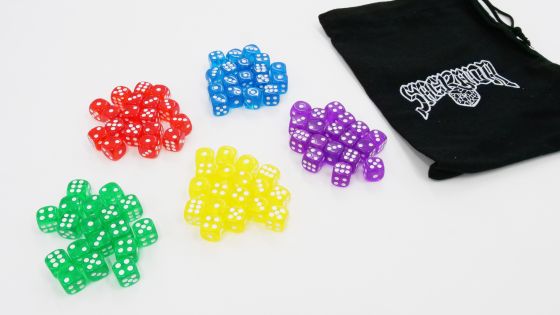
This is a 'window frame player board' and a 'window pattern card' that are dealt to players.
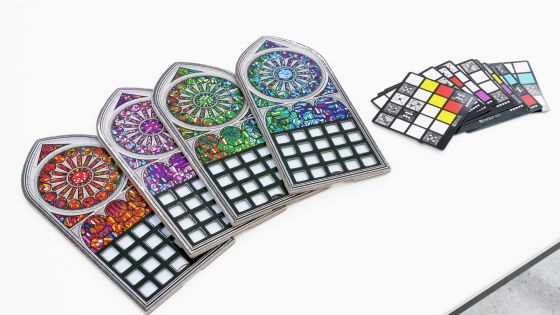
The window pattern card describes the conditions for placing the dice. Only the dice of that color can be placed on the squares filled with colors other than white, and only the dice of that color can be placed on the squares marked with the dice.

In addition, there are three types of cards: 'Individual Goal Card', 'Common Goal Card', and 'Tool Card'.
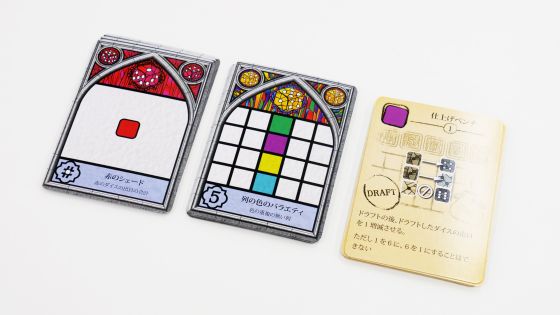
The common target card has 'color variety' with the condition that '5 points if the colors of the dice placed in one vertical row do not overlap' and 'the rolls of the dice placed in one vertical row overlap'. There are 10 types of score acquisition conditions such as 'Variety of vertical shades' with the condition of '5 points if not done'.

The purpose of this game is to get more victory points than anyone else by arranging the dice so that they meet the conditions of the window pattern card and also meet the conditions written on the common goal card and the individual goal card. ..
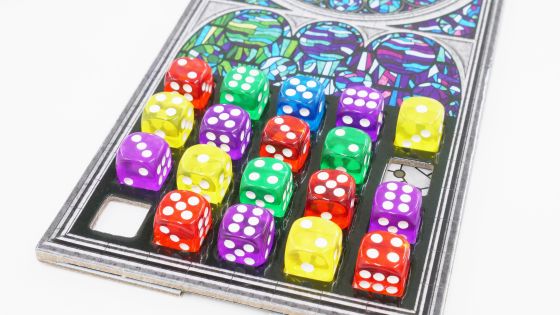
In addition, there was a 'grace token' like a glass ball consumed when using a tool card, a 'score marker' used when calculating scores, and a 'round track' that displays the progress of the game.
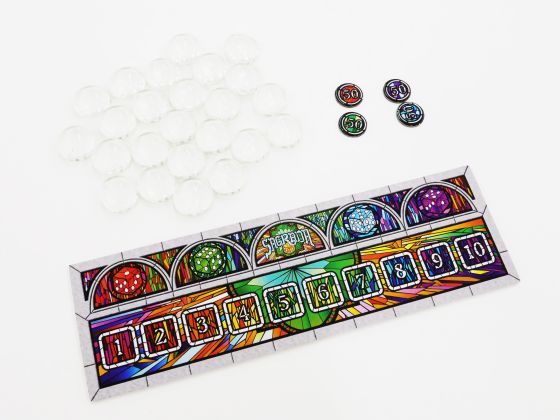
There is a 'score track' on the back of the round track, which is used to count points at the end of the game.
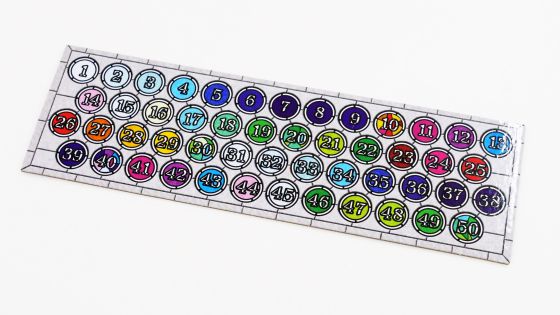
To start the game, first put 90 dice in the dice bag.

Then deal two window pattern cards to each player. Different window patterns are written on both the front and back sides of the window pattern card, and the player chooses the desired window pattern from the four window patterns and inserts it into the window frame player board.

After deciding which window pattern card to use for the game, you will receive as many grace tokens as the number of white circles in the lower right corner of the window pattern card. I received 5 this time.

Finally, when you receive one personal goal card and a score marker of the same color as your window frame player board, the player is ready.
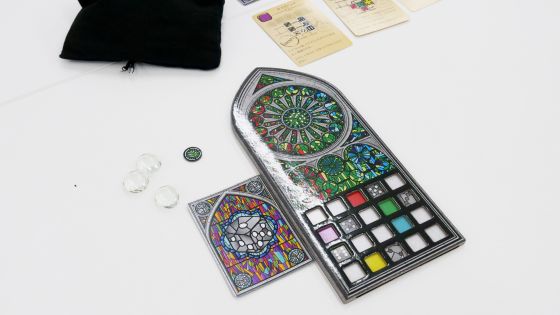
When the player is ready, randomly select and place 3 common goal cards and 3 tool cards under the round track placed in the center of the field to start the game.
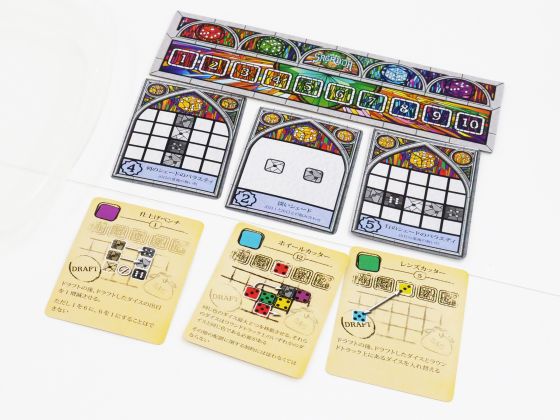
The game is divided into 10 rounds, at the beginning of each round the starting player removes the dice from the dice bag and rolls them. In addition, the instruction manual states that 'the player who visited the cathedral most recently' will be the starting player for the first round.

The number of dice to roll is the number of players doubled and 1 is added. This time I played with 4 people, so I rolled 9 dice.
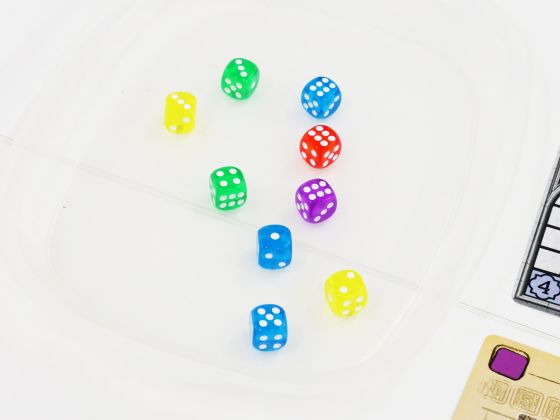
Players choose their favorite dice from the rolled dice and place them on the window sill player board. However, of the 20 squares that can be placed initially, only 14 on all four sides can be placed.
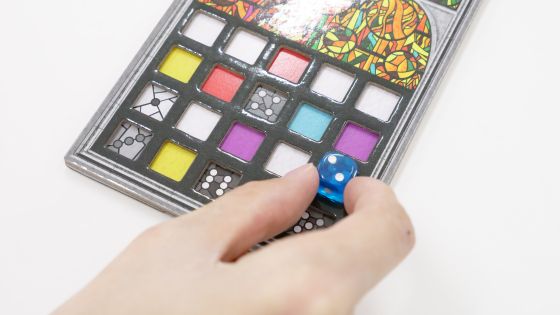
From the second one onward, place them so that they are in vertical, horizontal, and diagonal contact with the already placed dice. At this time, dice of the same color or the same roll cannot be arranged vertically and horizontally.
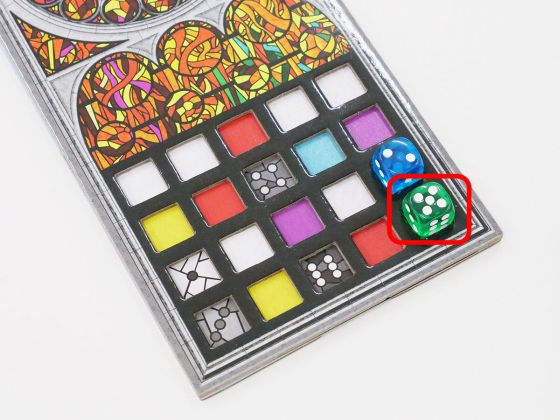
The turn during the round is performed in a clockwise order from the start player, and when the fourth player is reached, the turn is not turned to the start player, the fourth player processes the turn again, and the turn is counterclockwise to the start player. I'll put it back. In other words, there are two turns in one round. At the end of the round, place the surplus dice on the round track and pass the dice bag to the player to the left of the starting player to proceed with the next round.
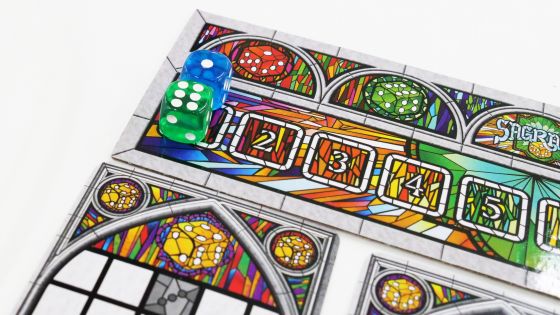
At the end of each round, there are only a few dice left. This time, two green dice with a second roll came around.
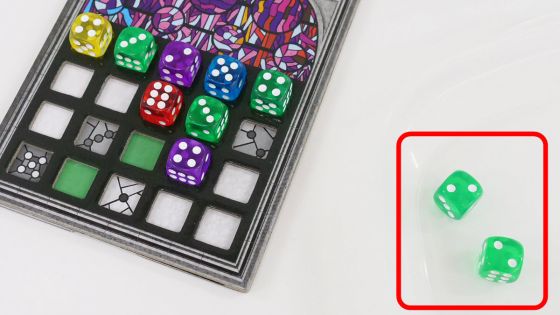
There is no choice but to put the green 2 on the window frame player board. You can no longer achieve the common goal card 'Vertical Shade Variety' in this row because you have two 2 rolls in the same row.

As the game progressed, the placement of the dice became like this. 'Vertical shade variety' cannot be achieved because the dice in the red frame are duplicated. Therefore, I decided to use the tool card to move the dice.

The tool card is used by placing the grace token at hand on the card during the turn. The first time you use an unused tool, you can use it with one token, but the second and subsequent use of the tool requires two tokens.
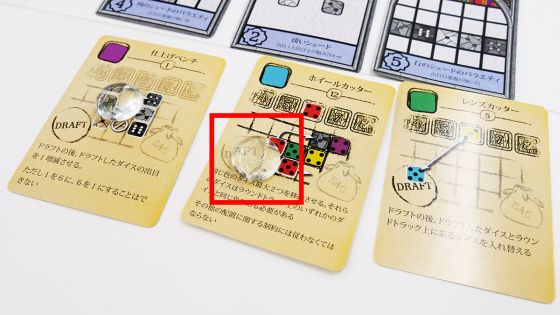
Moved two green dice by the effect of the tool card 'Wheel Cutter'. Now you can aim for 'vertical shade variety' again in two columns.
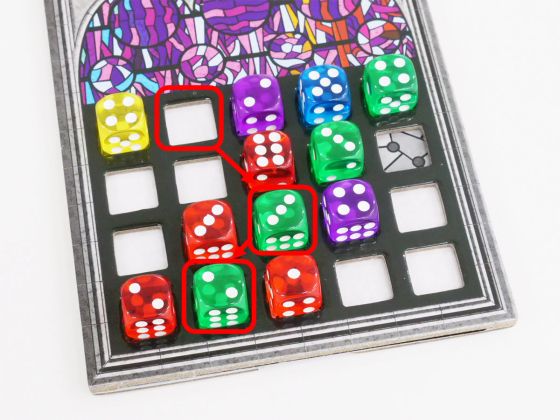
After playing up to 10 rounds, the game is over. Calculate the score.

First, you will earn 1 point for each grace token remaining at the end of the game, and you will lose 1 point for each square with no dice on the window sill player board.

Next, you will earn points according to the common goal card that meets the conditions. For example, if you have achieved 'Vertical Shade Variety' in 3 columns, you will get 15 points in 5x3.
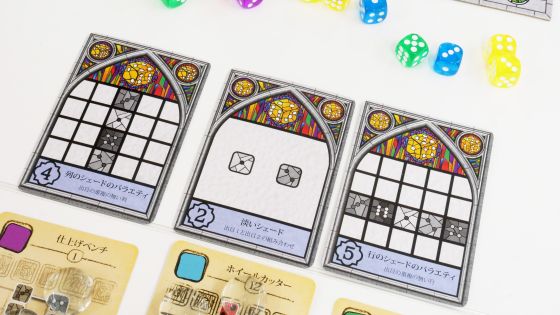
Finally, when points are earned according to the individual goal cards dealt to each player, the score calculation is completed.
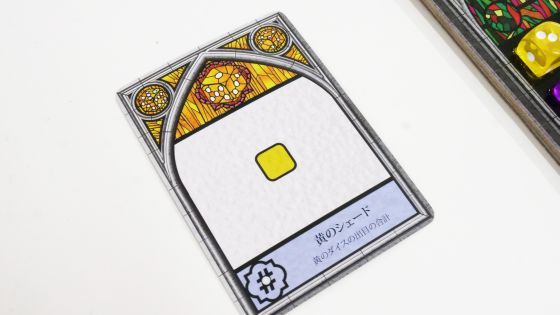
Your score is represented by placing a score marker on the score track. The score track has a number from 1 to 50, and if you get 50 points or more, turn the score marker over and show the side marked '50'. This time, the player who got 56 points won.
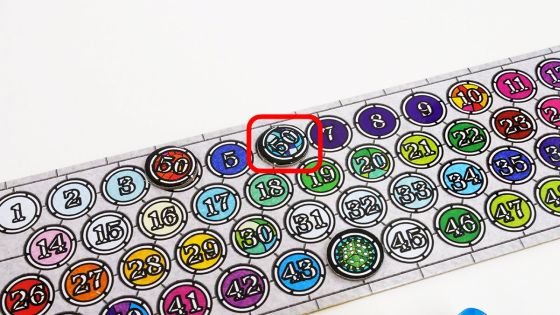
The window frame player board of the winning player looks like this. While placing dice on all squares, achieve 'Vertical Shade Variety' in 4 columns, 'Horizontal Shade Variety' in 3 rows, and 'Pale' with the condition of 'Getting 2 points for each combination of 1 and 2'. Achieve 3 sets of 'Shades' and earn points.
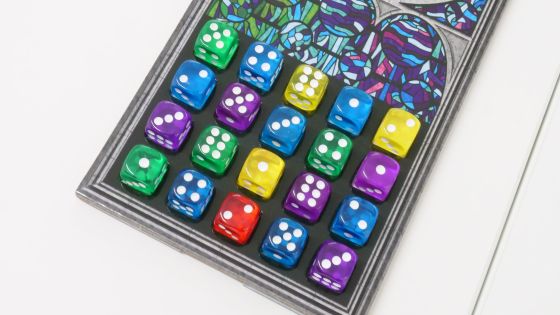
The maximum number of players for Sagrada is 4, but you can play with up to 6 players by combining it with the ' Expansion for 5 to 6 Sagrada' that can be played by 5 to 6 players . Sagrada 5-6 person expansion outer box looks like this.

Inside the box are a window frame player board for 2 players, 40 additional dice, additional window pattern cards, grace tokens, and score markers.
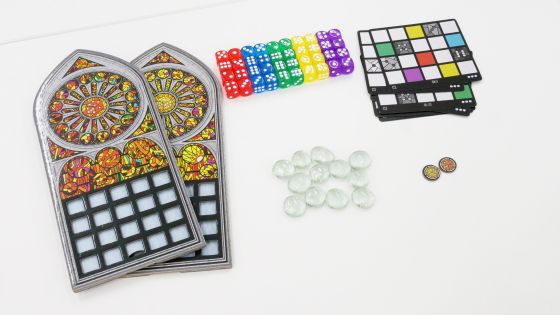
There were also 5 new common goal cards and 2 tool cards.
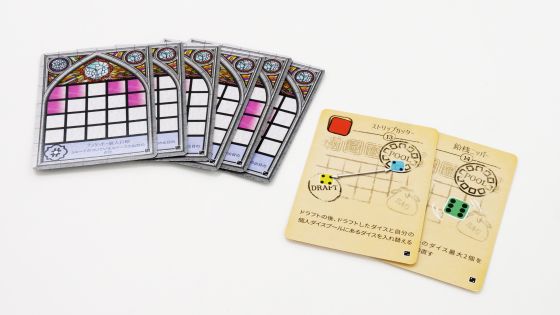
This is a 'personal dice pool board' that will be added in the Sagrada expansion for 5 to 6 people. When playing with this board, players can roll 10 dice and keep them in their possession at the beginning of the game.
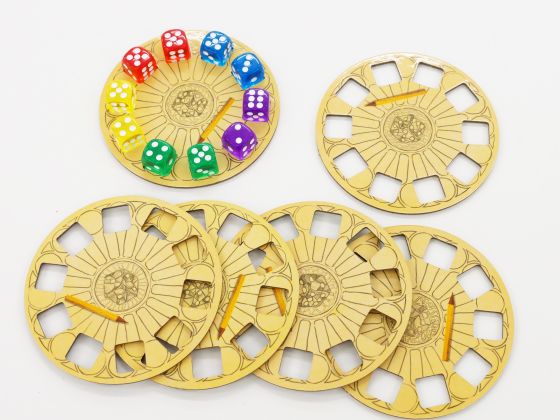
In addition, a dice tray was also included to store the rolled dice.

The maximum number of dice used when playing with 6 people is 130. It's an overwhelming number.
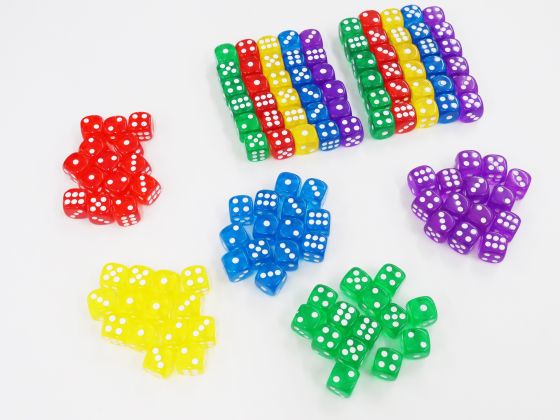
If you play with 6 people, you need a place to put not only the dice but also the window frame player board for 2 people, so you need a large space.
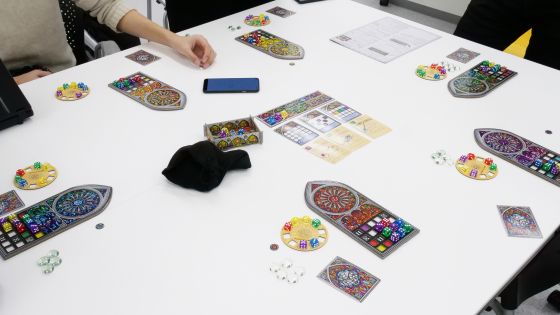
The basic rules are the same as for normal Sagrada when playing with 6 players, but if you use a personal dice pool, you can roll two 5-color dice at the beginning of the game and put them on the personal dice pool. I can do it.
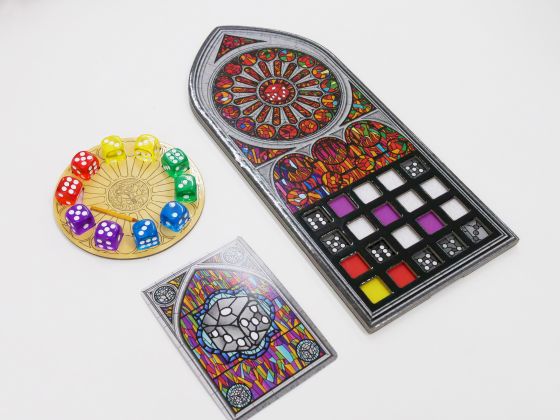
In addition, according to the normal rules, you played your turn twice in one round, but if you use a personal dice pool, you should start with one die from the start player in one turn ...

Select one die from your personal dice pool and place it on the window sill player board. Since two dice are placed in one turn, the game can be played at a good tempo even if the number of people increases.

When the game is over, the score will be calculated. The score calculation is the same as the normal rule, so I was able to enjoy playing with 6 people without any discomfort.
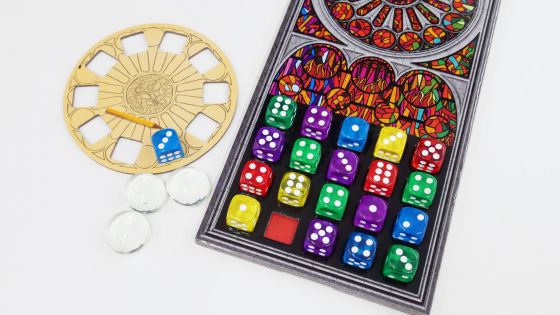
It looks like this when two people play. When the number of players is 4 or 6 players, it was a game like a party game that you can enjoy while rolling the dice, but if you play with 2 players, you can predict each other's strategies depending on the dice you choose, or get in the way of the other party. The aspect as a strategy game has become stronger, such as leaving dice like that.
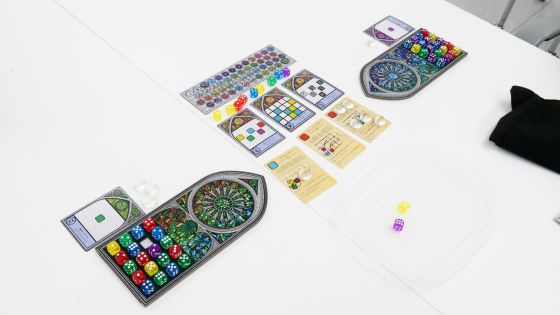
In addition, Sagrada also supports solo play. In solo play, roll 4 dice per round and aim to exceed the total number of dice rolled on the window frame player board by winning points. In general board game solo play, the difficulty level is often too high, but in Sagrada solo play, the difficulty level can be adjusted by preparing 1 to 5 tool cards, so there are various levels. It was made to be enjoyable by the players of.

When I actually played Sagrada, the conditions for earning victory points changed for each game, and the conditions for placing dice depending on the window pattern card also changed, so I was able to enjoy a completely different game for each play. In addition, since a large amount of dice are used, you can fully enjoy the 'fun of rolling the dice' and the 'feeling of excitement for the dice rolls'. It may seem difficult to look at because it uses a lot of dice, but when you actually play it, it's a simple rule, so it's a game that can be recommended even for board game beginners.
Sagrada is available at retail stores nationwide and online shops such as Amazon.co.jp.
Amazon | Sagrada Japanese Edition | Board Games | Toys

Related Posts:







